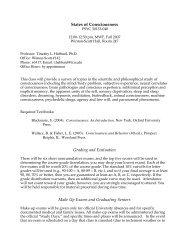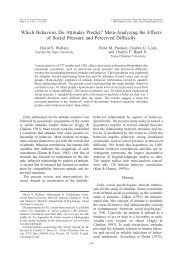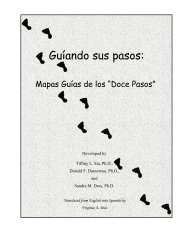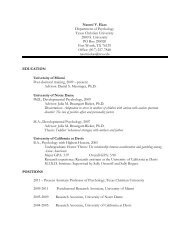TEXAS CHRISTIAN UNIVERSITY - Department of Psychology
TEXAS CHRISTIAN UNIVERSITY - Department of Psychology
TEXAS CHRISTIAN UNIVERSITY - Department of Psychology
Create successful ePaper yourself
Turn your PDF publications into a flip-book with our unique Google optimized e-Paper software.
(full text available electronically at http://www.drugabuse.gov/PDF/<br />
Perspectives/vol3no2/Assessing.pdf). [Abstract]<br />
Simpson, D. D., & Flynn, P. M. (Guest Eds.). (2007). Organizational readiness for change (Special<br />
Issue). Journal <strong>of</strong> Substance Abuse Treatment, 33(2). More Information on this special issue<br />
Simpson, D. D., & Knight, K. (Guest Eds.). (2007). Offender needs and functioning assessments (Special<br />
Issue). Criminal Justice and Behavior, 34(9). More Information on this special issue<br />
Learning Area<br />
KENNETH J. LESING<br />
Ph.D., University <strong>of</strong> California, Los Angeles, 2008<br />
“I study the ability <strong>of</strong> human and non-human animals to encode, store, and retrieve from memory the<br />
information (e.g., temporal, spatial, and causal) necessary for them to successfully navigate the world and<br />
obtain biological necessities. My research studies these processes from within an associative learning<br />
perspective, which predicts integration and competition among the objects that control behavior.<br />
Associative learning has long since been thought to be important for learning the predictive relationship<br />
between pairings <strong>of</strong> an object (e.g., a bell) and a reinforcer (e.g., food), but only recently has evidence<br />
emerged to indicate that much more (e.g., temporal, spatial, and causal information) can be learned from<br />
these seemingly simple pairings. For example, when several landmarks surrounding a feeding site are<br />
introduced in a piecemeal fashion (A-B, A-C) with a common element (A) they can be integrated in<br />
memory to generate novel inferences (i.e., B-C) that search behavior. My research uses Pavlovian and<br />
instrumental procedures to study the content <strong>of</strong> representations formed during learning and how these<br />
representations influence future responses (e.g., timing, location, and magnitude). With regards to the<br />
content <strong>of</strong> memory, my research has found evidence to support the acquisition <strong>of</strong> spatial (where),<br />
temporal (when), and causal (how) information during associative procedures.”<br />
Selected Publications<br />
Leising, K. J., & Blaisdell, A. P. (2009). Associative basis <strong>of</strong> landmark learning and integration in<br />
vertebrates. Comparative Cognition & Behavior Reviews, 4, 80-102.<br />
Leising, K. J., Wong, J., Waldmann, M. R., & Blaisdell, A. P. (2008). The special status <strong>of</strong> actions in<br />
causal reasoning in rats. Journal <strong>of</strong> Experimental <strong>Psychology</strong>: General, 37(3), 514-527.<br />
Leising, K. J., Sawa, K., & Blaisdell, A. P. (2007). Temporal integration in Pavlovian appetitive<br />
conditioning in rats. Learning & Behavior, 31 (1),11-18.<br />
Blaisdell, A. P., Sawa, K., Leising, K. J., & Waldmann, M. R. (2006). Causal reasoning in rats. Science,<br />
311, 1020-1022.<br />
Sawa, K., Leising, K. J., & Blaisdell, A. P. (2005). Sensory-preconditioning in spatial learning using a<br />
touchscreen task in pigeons. Journal <strong>of</strong> Experimental <strong>Psychology</strong>: Animal Behavior, 31 (3), 368-375.<br />
14






